World War 1 Weapons
1914-1918
U.S. 1917-1918
Contents
Land War
Poison Gas
Grenades
Flame Thrower
Guns
Rifles
Machine Guns
Artillery
Mortars
Sea War
Submarines
Torpedoes
Mines
Destroyers
Allies vs Central Powers
The basic strategy of all war is the amount of fire power that can be amassed to create the maximum destruction of the enemy. All battle tactics, maneuverability, mobility, supply, manpower and surprise are subjected to that principle. In the last years of the 19th century, and the early 20th century, ingenious minds were devising weapons with greater kill power and new methods for delivering death.
Most often, automation, albeit, mostly partial, and other advances in less labor intensive technologies, were the root solution. It was industrialization and its weapons by-product, as much as any single factor, that hastened the changes that swept over the world in the wake of the war.
The Turks and Germans lost empires. Vienna, the heart of central Europe, lost all vestiges of an absolute monarchy, and the victorious allies began to erase the class lines between the nobility and the society they had always dominated.
Land War
Poison Gas
The infantry was the blunt weapon on the battlefield. Its men controlled the forces that delivered the blows. Other branches of service, artillery, mechanized cavalry, air provided support for those men in the field. Multiple ways were required to weaken the strength of the foot soldiers. What more pervasive method than to poison their environment? Solution: deliver a deadly chemical compound first in cylinders and then, with advanced technology, in an exploding artillery shell.
World War 1 Weapons
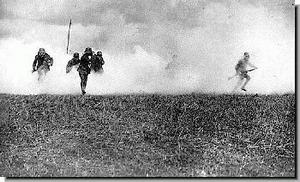
As early as 1860, scientists were experimenting with methods to synthesize chemical compounds into lethal gas.
Barely into the first year of the war, 1915, the Germans were about to release a chlorine gas at Ypres, Belgium.
The stunned British and French soldiers soon realized they were under a gas attack and they fled the battlefield.
The chlorine immediately attacked and burned the respiratory system and caused pneumonia.
The Germans had to delay their advance to avoid the contamination that lingered over the abandoned allied trenches.
The Canadians drenched cloth with urine,
placed over their noses, which tended to absorb the chlorine and then
recovered the lost ground. Ypres remained a battleground for the next
three years (1918) with over 1,500,000 casualties and uncounted civilian deaths. An unknown German corporal was awarded the iron cross for bravery at Ypres: Adolph Hitler.
World War 1 Weapons
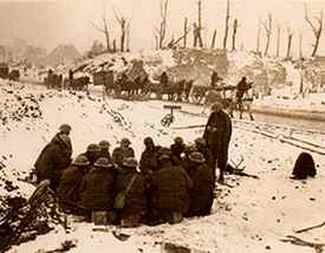
Subsequent to the initial chlorine gas attack, General John French of the British Expeditionary Force (BEF) at Ypres commented:
"The effect of the gas was so overwhelming that the whole of the positions occupied by the French divisions were rendered incapable of resistance. It was impossible at first to realise (sic) what had actually happened. Fumes and smoke were thrown into a stupor and after an hour the whole position had to be abandoned, together with 50 guns."
There was an immediate push-back to create defensive measures against the lethality of the gas. Efforts to protect the body against inhalation of harmful substances began 70 years before the war. Protective, rudimentary devices for fire fighters were designed to filter smoke and gas. In 1915, the British found that carbon monoxide emissions from unexploded shells were a threat to their troops. The German chloride attack added to the need for a speedy resolution. The Germans knew there would be reprisals in kind. They also would need protection. The earliest head covers and filter systems on both sides of the trenches were ineffective.
World War 1 Weapons World War 1 Weapons
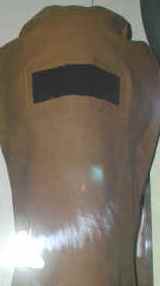 |
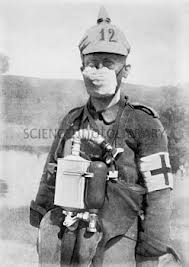 |
In 1916, the British improved the masks and added a filtering system with layers of charcoal contained in a metal box (small box regulator) which was adopted by the Americans in the following year (1917). The French had their version without a ventilator,that depended on a pre-soaked absorbant. The British unit was more effective than the French mask under a heavy gas attack
World War 1 Weapons World War 1 Weapons
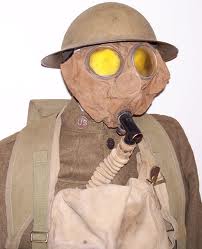 |
 |
The intensity of the war and its limited successes increased the pressure on the scientific community to create more deadly forms of gas. The Dow Chemical Company began the mass production of a new compound. phosgene, a colorless and volatile liquid, was introduced to replace chlorine (or added to the chlorine) in 1917. The product was known as "mustard gas".
It produced a mustard like odor and a yellow greenish cloud.
There were two types.
One type induced vomiting, and when penetrating the gas mask, forced its removal and then exposing the soldier to the second more deadly choking gas.
All of these gases caused external burning and blistering and designed to destroy the respiratory system.
Severe cases, short of death, could cause blindness. The gas became ineffective in cold conditions due to a freezing point at about 58 degrees Celsius. However, the gas that fell to the ground could remain lethal for many days.
World War 1 Weapons World War 1 Weapons
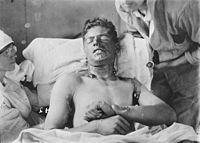 Burn treatment Blinded British Soldiers |
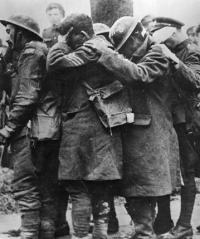 |
Grenades
The hand thrown grenade was a part of the infantry arsenal for 500 years (excluding the Chinese "hand bomb" in the 10th century). Its significance was recognized in earlier wars by the formation of special units known as grenadiers. The grenade, named by the French because of its pomegranate appearance, was a hollow iron ball filled with an explosive powder and fitted with a slow burning wick.
In 1914, the grenade was now in the hands of all infantry men and war planners sought greater sophistication.There were several models introduced by the major belligerents and greater thought addressed the safety of the "pitcher" to protect against premature explosion.
World War 1 Weapons
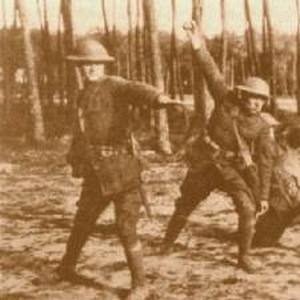
The German Command produced thousands of their Steilhandgranate (stick grenade). Their enemies referred to the weapon as a "potato masher". The grenade was used as an effective offensive weapon. "Offensive" because the attacking German could safely throw the grenade which would explode in a small zone without extending its range to the location of the advancing thrower.
In the first years of the war, the British responded with their version of the grenade. In 1915,
a Major Battye devised a hand held grenade filled with an ammonal
nitrate and TNT explosive, and closed with a wood plug and a simple
igniting device.The unit was relatively simple, but it set the course for further development.
World War 1 Weapons World War 1 Weapons
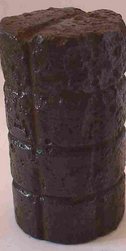 |
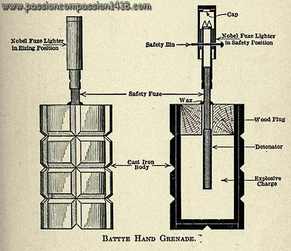 |
Within a year, Battye was largely replaced by the "Mills
Bomb" invented by English inventor William Mills.The Mills
grenade, heavily grooved, had the appearance of a pineapple and was referred to by the
name of that fruit. This was a defensive, fragmentation weapon that upon
its explosion small, lethal fragments would swiftly be dispersed in the
area in which it landed. However, the landing area was much greater
than its German counterpart and exposed the thrower. Thus the thrower would throw and immediately seek cover to avoid the flying particles. The "pineapple" could be thrown accurately about 50 feet, but its killing zone could be 100 yards.
World War 1 Weapons World War 1 Weapons
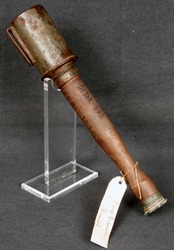 |
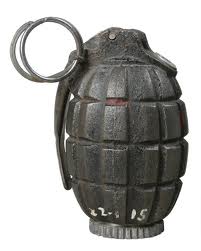 |
England's French ally developed its own fragmentation grenade. They, also, underwent a horizontal evolution. In 1916, some systems favored an internal fuse and a grenade with an exterior percussion fuse. In 1917, the Americans had not developed their own workable grenade, and favored the French internal fuse type known as F1 similar in shape to the Mills grenade pictured above.
The French dug back into more ancient history to find an old delivery system for its grenade to increase its range. They utilized the catapult. A more modern effort utilized the grenade attached to a rod and affixed to a rifle.
World War 1 Weapons World War 1 Weapons
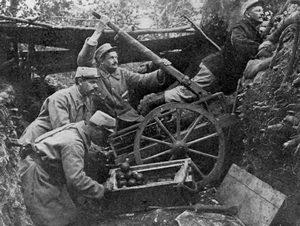 |
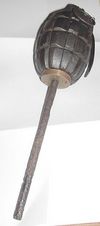 |
The United States, after initial failure in developing its own grenades, would ultimately create weapons that were either explosive in nature or carriers of chemicals or gas. The pineapple shape augmented the fragmentation and increased its lethality.
White phosphorus was used in grenades to create smoke, for illumination (a property of phosphorus) or incendiary to induce fires and burning.
World War 1 Weapons
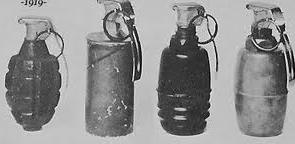
Flame Throwers
In 190l, a German inventor (Richard Fiedler) produced the first flame thrower (flammenweifer) that first appeared on the western front in 1914. The genesis can be traced to the Byzantine era when a stream of fire ("Greek Fire") was hand pumped against enemies and used primarily at sea. The first such attack on French trenches in WW1 was recorded in February 1915 at Malencourt just north of Verdun.
It was an offensive weapon aimed at enemy trenches to support advancing German troops. It was most effective in a range of 20-30 feet, but had a range up to 100 feet. It was intended to shock the enemy and the German troops ( six man squads) who utilized the weapon were called "shock troops"-- predecessors of their World War II storm troopers. The downside was that they were marked men for allied snipers. When captured, they were immediately executed.
The British experimented with the flame thrower, but appeared to have little success and it never became part of it arsenal of weapons. The American Marines used a highly effective flame thrower against the Japanese in their Pacific Islands campaign in World War II.
The unit was portable and carried in tanks on the soldier's back. It used a pressure system to force highly flammable oil from a back cylinder that mixed with a propellant gas from another tank through an igniting valve (gun). It then sprayed the flame through a tube and nozzle like apparatus.
World War 1 Weapons
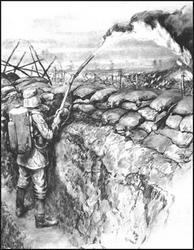
Drawing by A. Forestier
Air War
Less than five years after a United States reconnaissance balloon flew over a Cuban battlefield (Spanish American war 1898), Orville Wright flew a heavier than air fixed-wing bi-plane over a Kitty Hawk beach in North Carolina. The 1903 flight rose for a 3 second flight lifted by the power of an engine. It also established a standard for controlling an aircraft. By 1908, they sought a contract with the United States Army (and with the Germans, and the British ). No sale! However, in that year there was a breakthrough contract with the U.S. Board of Ordnance to build a plane based on the specifications of the Wright brothers.
World War 1 Weapons World War 1 Weapons
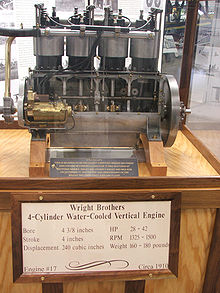 |
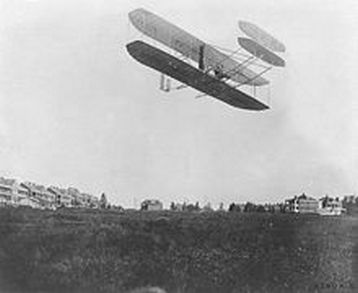 1910 |
However, in hindsight. it is apparent that the United States Army brass did not view the airplane as a strategic weapon in war time. As an interested bystander to the conflict in Europe, the army did little to create an air arm. Factually, more seaplanes were being manufactured in the design of the Curtiss Flying Boat and served in naval air duty. In its earliest form, there was a single cockpit with room for pilot and passenger with an engine mounted between the struts and over the pilot. Between 1912 and 1918 there were numerous variations which increased its size to a six person occupancy.
This seaplane had an operating range of almost 400 miles, and it could operate at about 70 MPH. Its wing span was 43 feet and body about 27 foot length. It carried a small bomb load and was protected by machine guns. This plane was most effective in convoy duty in anti submarine duty, and the first to shoot down a German zeppelin over the North Atlantic. Zeppelin's were in use by the Germans in 1914 and used to bomb the Belgium town of Liege. By mid 1918, there were 900 seaplanes on line, and 400 active over European waters. German ally, Austro-Hungarians, built their version of a "patrol boat" named Lohner L. (lower right).
World War 1 Weapons World War 1 Weapons
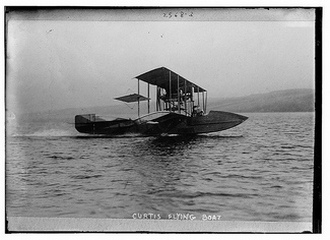 |
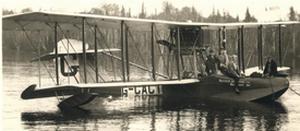 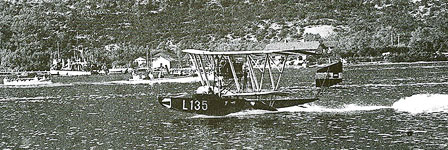 |
In 1914, the quality of the planes was questionable. There were too many casualties from structural defects. Yet the belligerents recognized the tactical and strategic value of the aeroplane (as it was known), and strove to manufacture a better product. The fabrics, cotton, silk, linen, that covered the wings were highly flammable. Later in the war a dope product was introduced into the fabric which maintained its tautness. Until the introduction of that development, recovering the fabric surfaces of the plane was an ongoing activity. The wooden bodies remained the standard, and metal frames did not come into use until late in 1918 when introduced in the German Junker J9 fighter. The maneuverability of the Junker as a fighter was problematic, but deemed highly serviceable for their navy.
World War 1 Weapons
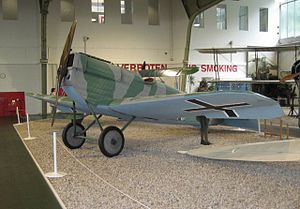
Reproduction--Berlin Museum
In the early years of the war, the biplane was used primarily for
reconnaissance. The plane would hover over enemy lines and act as an
artillery spotter. It also reported on troop movement. Air photography using glass plates and Kodak cellulose film were regularly used. Military historians
believe that the plane was a deterrent against surprise attacks and
maneuvers, and a significant contributor to the trench war stalemate. Later in the war, planes from each side engaged in "trench strafing" which created havoc for the men seeking cover. The French Salmson 2A2 was a typical reconnaissance plane that was also used by the American pilots.The American Expeditionary Force (AEF) purchased 705 from the French.
World War 1 Weapons
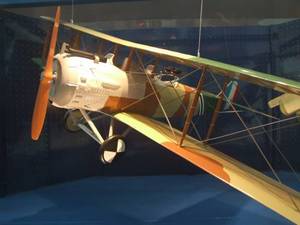
On the western front, westerly winds would impede returning French and British planes to their lines causing them to land in enemy territory. Their pilots were captured, and held as prisoners of war. Additionally, visibility was limited to about one to two miles in spotting a single aircraft. Furthermore, the altitudes for observation were low enough that the planes were exposed to rifle and machine gun ground fire. The famed German ace, Manfred von Richtenhofer, "the Red Baron" reportedly was hit from the ground and plunged with his Fokker biplane to his death into Australian lines. Respect for him earned a grave side "royal salute" held by the Aussies.
World War 1 Weapons World War 1 Weapons
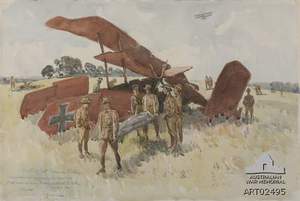 |
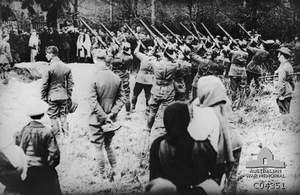 |
The single (mono) wing, bi and tri wing aeroplanes (British variant of airplane) flew with either single or double open cockpits. All were in service at the same time. As the war progressed, speeds up to 100 MPH became the norm. During the war, there were well over one hundred different aircraft in service. Each original model was, with almost no exception, updated and revised numerous times. The rear, open seat, occupied by the observer, was armed with a machine gun. The gun could be sighted on a passing enemy plane, but its circle of fire was limited by the presence of the pilot in front of the gunner.This left the zone in front of the pilot exposed to the enemy observer's weapon.
World War 1 Weapons
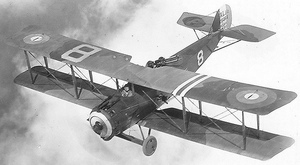
It was evident to the designers that the placement of a machine gun in front of the pilot's eyes, much like a riflemen sighting along the rifle barrel, was the appropriate location. At first, the engineers mounted the gun on a wing alongside or above the pilot. The position distorted the aim of the pilot and interfered with the concentration required to operate the plane. The challenge was locating the gun on the nose of the plane, in front of the pilot, without its projectiles striking the rotating propeller. That problem was solved by timing the gun's sustained bursts with the propeller's rotation--synchronization. The gun was then emplaced and operating in the direction of the moving plane.
The pilot then became an
offensive participant in the sky battle that often placed him within yards
of the enemy plane. It also required a high degree of skill to survive.
Pilot's learned to use their environment with its limited visibility. They would attack when the sun was in the enemy's eyes. Dive, like a projectile, at high speed from cloud
cover aimed at the plane below. This latter tactic and superb maneuvering tactics were perfected by the
German ace, Max Immelman (below). His plane of choice was the single wing
fighter, Fokker EL, that became his funeral bier in 1916. His name and maneuver is synonymous and survives generations of pilots.
World War 1 Weapons World War 1 Weapons
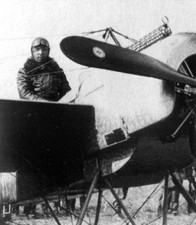 |
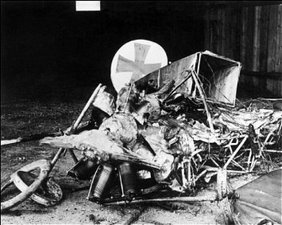 |
Both the Entente powers and the German Alliance immediately noted the value of air observation. Starting in the first year of the war, the opposing powers sought to diminish the tactical advantages of these aerial observers, and set a course to turn planes into fighters intent on shooting down the intrusive enemy aircraft.
World War 1 Weapons
|
The British had several active factories manufacturing fighter aeroplanes including a Royal plant.The Sopwith Camel, manufactured by a private factory of that name, was temperamental, difficult to fly, but an extremely good fighter when mastered. They were credited with over 1,000 victories. |
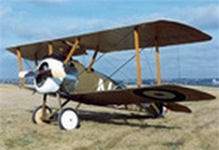 |
The French had been on the cutting edge of developing heavier than air manned flight and had been outraced by the Wright brothers. It was no longer a flight of fancy in 1914. They maintained their belief in the value of the aeroplane, and particularly its importance as an offensive weapon of war.
World War 1 Weapons
|
The French fighter, Spad S XIII, was the equivalent of the British Camel. It was a highly efficient single seat plane and the choice of American WW1 Ace, Eddie Rickenbacker in 1917. He had 26 victories and was recipient of the Medal of Honor. |
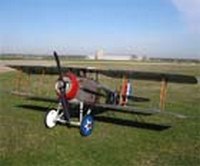 |
The Germans began the war with definitive air superiority. They maintained that edge for a number of years until the British and French were able to produce fighters that matched the Germans in the air.
In April 1917, 38 American pilots led by Norman Prince joined the French Army air arm. They were known as the Lafayette Escadrille. Before their later incorporation into the American Expeditionary Force, they had lost nine of their brothers. They flew the Spad as well as the exceptional Nieuport (below) with their unique Indian Brave's head insignia.
World War 1 Weapons World War 1 Weapons
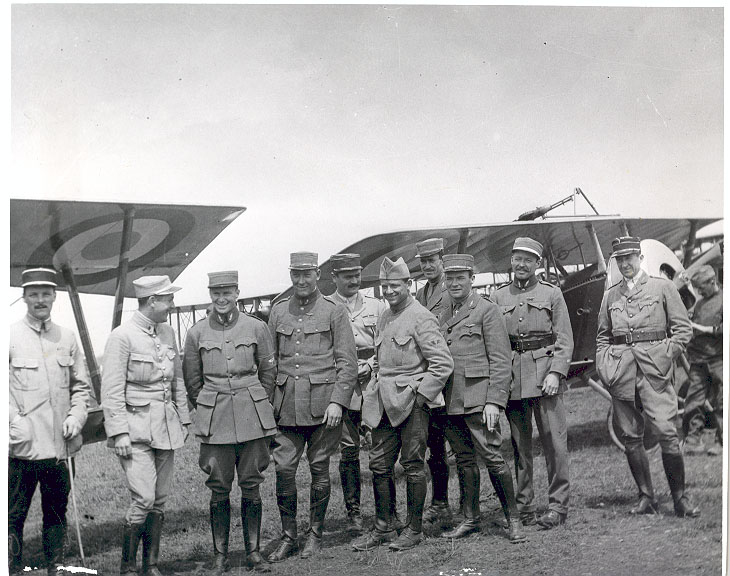 |
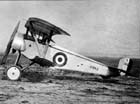  |
The French and British aeroplanes had matched well against the German Fokker D.VIII. However, in 1916, the Germans restored their air superiority with the introduction of the Albatross D.Va. That plane and the Fokker monoplane (single wing) were the principle bulwarks of German air power until the end of the war.
World War 1 Weapons World War 1 Weapons
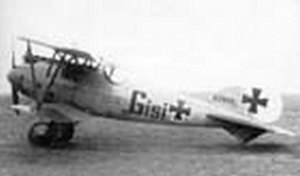 |
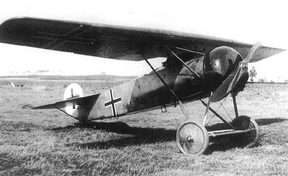 |
World War 1 Weapons
|
German cities were not immune from bombing attacks. Planes were built
with the capacity to carry small bomb loads that were either manually
dropped or from bomb racks with rudimentary bomb sights. At first, Kaiser
Wilhelm had forbidden bombing London fearing he could injure his English
relatives in their royal palaces. Indiscriminate British bombing forced
the kaiser to reverse his forbearance. Zeppelins were also active in
bombing raids but heavy losses to its large crews necessitated replacement by the bomber. |
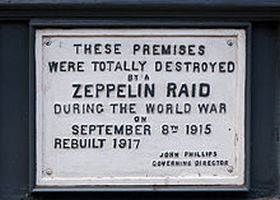 |
The German Imperiale Air Service introduced the Gotha bomber (1917). It had a unique configuration with a bombardiers cockpit in front of the pilot. They were constructed of wood and steel and mounted two Mercedes engines. Their last night time bombing raid over London resulted in severe losses inflicted by British interceptors, anti aircraft fire and poor landing visibility on return to the continent (May 1918).
World War 1 Weapons World War 1 Weapons
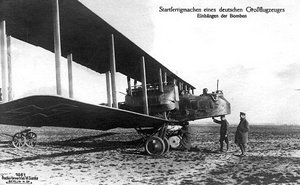 |
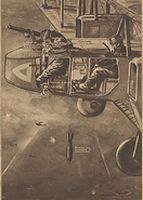 |
World War 1 Weapons
|
The British countered with their behemoth Handley Page: 100 foot wingspan and 63 feet long. It mounted two Rolls Royce engines on either side of the fuselage.Similar front bombardier cockpit as German Gotha. |
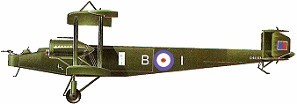 |
Although the American industrial empire rivaled the largest in any European nation, its effect on aeroplane technology and production was negligible. Their air arm ranked 17th in the world. When they entered the war in 1917, they were largely dependent on purchases of all types of weapons and airplanes from the French and British,
General Mason Patrick, a non pilot, was named to head the US Air Service. To the surprise of the service's regulars, he performed admirably. When his forces landed in Europe, Colonel William (Billy) Marshal set up training camps in England and France.
The first test under fire for independent American action was to assault and capture the St. Mihiel salient. This German bulge onto French soil had been held by them for four years and had successfully defended against allied attacks. Four days after the attack by joint forces of Americans, British, French and Portuguese soldiers the salient was breached and retaken. air action was negligible.
Colonel Mitchel was in command of 1481 planes. His assignment was to plan an air assault with the objective of bombing, reconnaissance and pursuit to be coordinated with ground forces. Military strategy had not as yet progressed to allow independent air action. He was to engage in the largest air battle of the war. He commented on the sheer number of orders he had to issue:
"When commanding, I always drew up my own orders for the military operation of the fighting units, and personally checked the sending and receipt by the unit commander of their special orders. When orders were not obeyed, it was usually the commanding officer who was at fault. Either the orders had not been delivered or they were so written that nobody could understand them. I always kept an officer at my headquarters, whose name I shall not mention, who I had read all the orders. If he could understand them anybody could. He was not particularly bright but he was one of the most valuable officers I had".
Opposing the U.S.army air force, were about 500 German planes. Although the skills of the combatants were equal, sheer weight of numbers and steady, persistent attacks dictated a win for the Americans. Each side had lost 60 odd planes, but the American pilots had penetrated German airfields and destroyed them.
Sea War
Above and Under
Britain may never have entered the war if it were not for missteps and misstatements of Kaiser Wilhelm II, Monarch of a unified Germany.
His invasion of Belgium in 1914, not entirely necessary, was a breach of an 1839 treaty obligation that Britain was constrained to respond to with armed force.
Wilhelm's statement that he would build a navy to equal that of Great Britain was a direct threat to the British overseas empire.
Wilhelm codified the naval threat in a series of measures emphasizing the warning to Britain.
He created new cabinet positions that elevated the navy as a separate department, and on equal footing with the Imperial Military cabinet.
Large sums were expended to increase the size of the German fleet. Prior to the outbreak of war, this heightened activity caught the attention of the American public.
World War 1 Weapons World War 1 Weapons
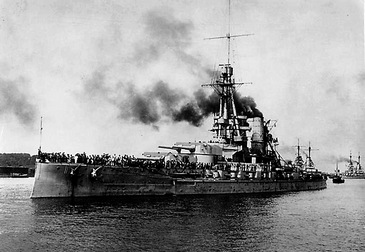 Library of Congress |
 |
As the war progressed, Wilhelm's authority was ceded to the old line Prussian military commanders. Admiral Alfred von Tirpitz controlled the fate of the German navy with its 31 battleships. 7 battle cruisers and less than 50 "unterseeboots"--the submarine known as U Boats. By 1918, ten German shipyards had built 400 submarines, but only about 140 on active call. In actuality, only sixty were at sea at one time. The Krupp factory was a principal supplier of steel and maintained their industrial ascendency through Germany's World War 2 years.
World War 1 Weapons World War 1 Weapons
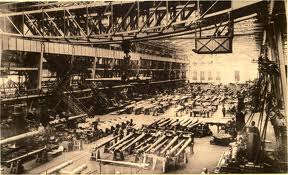 |
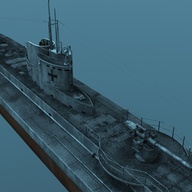 |
The British began the war in 1914 with a larger submarine fleet than Germany. Their utility in the Atlantic was hampered by the quality of their blockade on German shipping. Targets were few and hence their need was diminished. Nevertheless, one British submarine had some victories in the North Atlantic against smaller German naval vessels. However, they did have some value in the Baltic Sea where the German fleet maintained bases and operated in more safety than in the Atlantic. The British surface fleet, toward the end of the war, succeeded in trapping those bases and forced the Germans to scuttle their ships.
Each fleet had a common strategy. Control the sea lanes and starve the population dependent on food supplied by other countries---neutral or otherwise.
The French began the war with 60 submarines. An agreement between the allies provided for a division of naval forces with Great Britain. The latter controlled the English Channel and the Atlantic. The French patrolled the Mediterranean Sea with their Italian ally.. Their other ally, Russia, reportedly had a fleet of about 50 submarines which were purchased from other nations including Germany. Their activities and lack of success were duplicated their military counterparts on land.
The United States in 1917, had built few submarines known as the K class and probably based on British design. Technologically they were well behind. They had problems with the basics. It took five minutes to submerge the boat. Twice the time necessary to protect the boat from enemy guns.
Although the German subs had sunk over twelve million tons of enemy and neutral shipping, their own vulnerability kept many in home ports. Their part in the war proved so devastating that the Versailles Treaty in 1919 specifically forbade the Germans from building submarines. The Germans easily avoided the provision by training their submarine personnel in Spain and battle ready for world War 2.
The submarine was generally 114 feet in length and carried a crew of 35 elite personnel. Its general principles were tested in the American civil War and then in the Russo-Japanese war earlier in the 20th century(1904). By 1914, submerging operations were completed by filling a tank in the hull with sea water which pushed the air in that tank into another flask and then adjusted for buoyancy. To surface, the operation was reversed by pushing air from the flask into the tank. Surfacing in less than 24 hours was necessary to replenish the air supply. When the submarine was hunted and air was in short supply, the crew's activity was limited to diminish their requirement for oxygen, and the absolute necessity to surface to replenish the air supply.
The submarine carried a 12 pound deck gun that protected it when on the surface,
but also could be used as an offensive weapon against enemy shipping to supplement their five torpedo tubes.
World War 1 Weapons
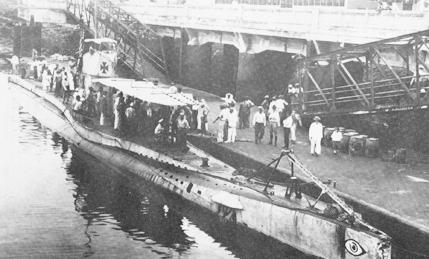
The U boats operated with diesel combustion engines and when submerged they viewed the surface through a periscope. Above all, the hull had to be constructed to withstand the pressures of the deep oceans. Their range was extensive.They hovered off the American east coast and from a port on the Adriatic coast, and put Italian shipping in the Mediterranean at risk. In 1916, the U 35 sunk an Italian ship with a loss of life of sixty sailors. In another 1916 venue, a U-boat captain anchored his sub in international water off the Newport, Rhode Island coast. He came on shore, gathered supplies, to the surprise of residents, and returned to his boat where he calmly attacked merchant vessels.
World War 1 Weapons World War 1 Weapons
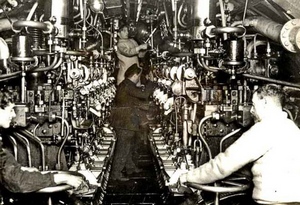 |
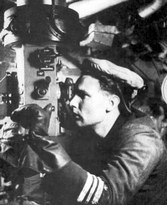 |
The submarines required repairs and supplies when at sea. Sub tenders were floating dry docks and could rendezvous with the subs. They were capable of lifting a sub off the sea floor. Their bow formed a large open funnel over the sea that allowed the surfaced submarine entrance into the heart of the tender.
World War 1 Weapons
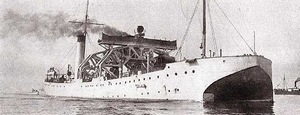
In early May 1915, RMS Lusitania left New York Harbor bound for Liverpool. The passengers had received a warning from the German embassy that the ship was considered an enemy carrying contraband to England, and would be a target in a zone set up by the Germans. On May 7, the boat was torpedoed 11 miles off the Irish coast (in the German prohibited zone). It was sunk by U-Boat 20 (second from left below) with heavy loss of civilian life including 126 Americans. The tragedy was a source of anger and regret in the minds of the American public when they supported U.S. direct involvement in 1917.
History has since revealed that the passenger liner was carrying about 170 tons of munitions to Britain.
In the U-boat log, Captain Walter Schweiger viewed the scene and wrote:
"The ship stops immediately and heals over to starboard quickly, immersing simultaneously at the bow. It appears as if the ship were going to capsize very shortly. Great confusion is rife on board; the boats are made ready and some of them lowered into the water. In connection therewith great panic must have reigned; some boats, full to capacity are rushed from above, touch the water with either stem or stern first and founder immediately."
There was an unwritten code that the submarine would first warn
passengers to off load in life boats, but because of a counter policy
that advised ships to ram the submarine they did not adhere to the rules.
World War 1 Weapons World War 1 Weapons
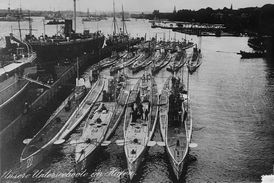 |
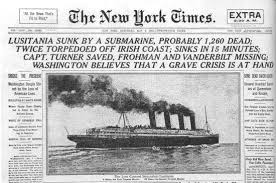 |
In 1914, the HMS Barham, a new British battleship, served relatively unscathed through the entire war. In 1941, in the early years of WW2, it was struck by a U-boat torpedo and sunk almost immediately as portrayed below.
Torpedoes
The torpedo, a term coined by the inventor of the steam boat, Robert Fulton in 1800, was used in its many forms and names (mines etc.) for hundreds of years. The means of propelling the explosive weapon aimed at an enemy target had always challenged inventive minds. Solutions for utilizing such a weapon on land were generally more productive than using the weapon at sea. In the late 19th century, engineers had gained a greater understanding of the various means of fueling engines and their potential to propel lethal weapons.
World War 1 Weapons
|
British engineer, Robert Whitehead, in 1875, focused on the propulsion of the torpedo. He produced an engine powered by compressed air that drove a propeller. He then devised the means of controlling the depth of a moving torpedo. |
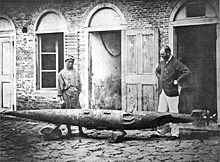 |
In order to increase the speed to the target, additional problems were posed. Increasing the air pressure, sometimes caused icing in the combustion chamber. That was solved by igniting a fuel (kerosene) to heat the air. Evolution of the technology was rapid. When overheating was a problem, cooling was accomplished by using seawater. The former was known as a dry heater, and the latter, wet heater, which became the standard that stretched its use into WW2.
The size of the torpedo ranged from 19 feet to 21 feet. The U.S. used a a standard 21 inch diameter while their Japanese WW1 ally, with its wet heater, built the torpedo with a 16 inch diameter.
On April 6, 1917, U.S. Admiral W.S.Sims was on a secret mission to England. His ship was struck by a submarine torpedo. Fortunately the boat did not sink. On the following day, the United States congress declared war on Germany.
World War 1 Weapons
|
As the 19th century was closing, the first launch of a torpedo from a submerged sub was accomplished by the Ottoman navy, ultimately, a German ally. Abdulhamid |
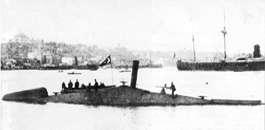 |
The torpedo was adaptable to all environments: under and on the sea and from the air. In each case the three components were: a propulsion system, a guidance system and an explosive system. The early, courageous airmen who flew sea duty were from the anti air craft guns mounted on the ship's deck firing 66mm projectiles at the plane.
World War 1 Weapons World War 1 Weapons
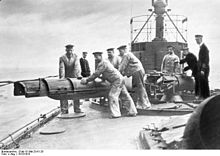 |
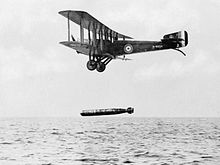 |
Mines
Beneath the waves the submarine could be used to lay mines from its tubes when submerged in coastal waters. When the submarine was used this way, the boat carried the mines instead of torpedoes. This was particularly a problem for Great Britain with its numerous ports in several oceans and seas. Pictured below: the UC-5 with mines on its deck, It was subsequently captured by the British and displayed as a trophy in New York City.
World War 1 Weapons World War 1 Weapons
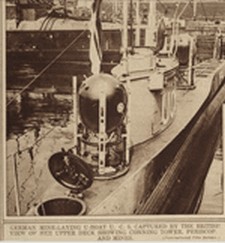 |
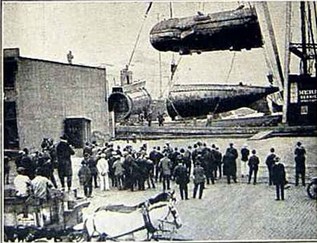 |
The Hertz Horn, pictured below, was affixed to the mine. When struck by a boat's hull, it triggered an acid which energized a battery to explode the mine. It's success was copied by the British and ultimately by the American navy.
Germany laid 43,000 mines resulting in sinking 44 Royal Navy ships and 497 merchant ships. As a counter measure, in 1918, the U.S. Naval Squadron stationed in the North Sea, operating under British command, was ordered to enforce the blockade against German ships. They lay a mine field that included submarine depth. The mine field stretched 245 miles by 35 miles wide. At least 4 U-boats were sunk. This was known as the North Sea Barrage.
World War 1 Weapons World War 1 Weapons
|
October 27, 1914 HMS Audacious struck a mine and was sunk. 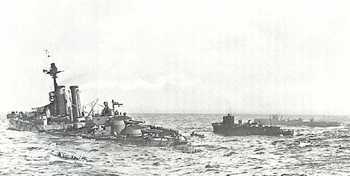 |
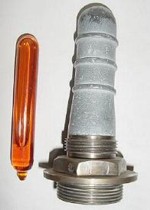 |
The British converted many luxury passenger liners into mine laying duties. The Princess Irene was built and launched in 1914. The Royal Navy called her to duty in 1915. In May of that year, the Irene was sailing in English channel waters when it exploded losing 352 lives.
World War 1 Weapons
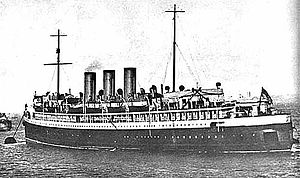
|
Mine Sweepers Simple fishing trawlers were often employed to cut the mine cables and then exploded with a rifle shot from the deck. The bows of those ships were heavily armored to protect against blast shrapnel. The U.S. navy developed a fleet of mine sweepers with more advanced mechanical methods. USS Eider |
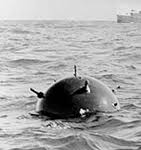 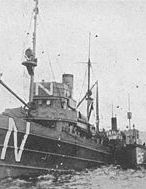 |
Failure of the Big Ship Strategy
The war began with an implied challenge from the German command directed to the British Royal Navy.
The Germans had expended huge sums to build up their navy.
In 1914, the German "High Seas Fleet" was top heavy with 19 new dreadnaughts, 22 semi-obsolete battleships and heavy and light cruisers.
In addition, they had a separate arm for a U-boat fleet which would ultimately build about 400 undersea craft.
However, no more than 140 were operational at one time, and never more than 60 at sea.
The opening shot of the war in August 1914 was fired by a destroyer, HMS Lancer, against a German mine sweeper.
In 1914, the Germans appeared content to use their surface vessels to raid and bombard northern English coastal towns. However, their submarines operated at great distances from their home ports.
There were several naval failures suffered by both sides that convinced each that the huge surface navies could not win the war, and each sought measures that produced partial answers pointing under the sea to mines and submarines. The Jutland and Dardanelles campaigns epitomized strategies that did not work, and the change in tactics that failures dictated.
World War 1 Weapons
|
Despite the best efforts of the German shipyards and steel mills, the British Royal Fleet maintained a numerical superiority. The Krupp Industry was setting a German standard for building war materiel. Along with the Skoda factories their industrial power would last well into World war 2. |
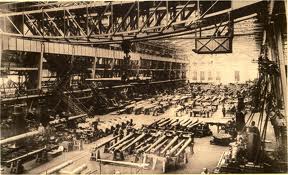 |
World War 1 Weapons
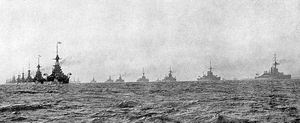 |
During the years 1914, 1915, the British ships were establishing a blockade of the continent that was so intrusive that their submarine fleet had few merchant ship targets. |
1915: First Lord of the Admiralty, Winston Churchill, desired to open a second front against the Germans. In early March he was determined to seize the Dardanelles Straits and Constantinople from the German ally, Ottoman Turks. The Turkish fleet was at the time bombarding Russian coastal cities on the Black Sea. Thus two purposes would be served. A second front against the Germans to divert some of their resources from the European Western front in France, and to relieve the Entente's Russian ally from Turkish pressure. In conjunction with French and Australians Churchill commenced the sea campaign.
World War 1 Weapons
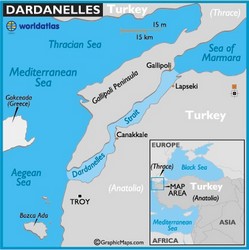
GraphicMaps.com
The combined might of three navies, over 100 combat ships and submarines, were thrown into the battle against the Turkish coastal forts and heavily mined waters. The attack was a disaster. Several battleships, the cream of the fleet, were sunk. The French battleship, Bouvet lost a crew of 660, and the British battle ship, Irresistible, lost 150 sailors.
World War 1 Weapons World War 1 Weapons
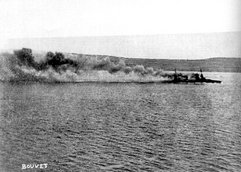 |
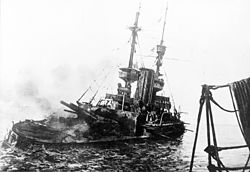 |
To compound the disaster in the following year (1916), Churchill ordered the amphibious invasion of the Gallipoli peninsular with heavy fleet support. That followed with another failure and the exit of Churchill from the Admiralty.
In 1916, the British and Germans were tacitly ready for a grand clash of their fleets. The venue was the North Sea off Jutland on the Danish coast.
World War 1 Weapons
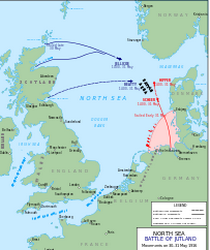
The Germans massed 99 ships including 16 dreadnaughts, 6 pre-dreadnaughts, 6 light cruisers and 31 torpedo boats.The British readied over 150 combat vessels that ranged from 28 battleships, 80 destroyers and a seaplane carrier. The battle was joined on the night of May 31, 1916. Germans sunk 14 ships and lost 11 vessels. Casualties were horrendous. Six thousand English sailors were killed and the Germans lost 2500.
Both sides declared victory, but, in reality, the results were inconclusive. What was apparent to the German Admiralty that the war would not be won on the sea with grand battles. They prevailed on Kaiser Wilhelm to restart an unrestricted U-boat campaign. All neutral shipping was fair game. American interests were particularly affected.
The Congress passed the Naval Act of 1916 that promised a larger, more robust navy that would outclass the combined tonnage of any two European powers that included ten battleships, six battle cruisers, thirty submarines, and fifty destroyers, and other support vessels. The construction program would proceed over a three-year period.Two months earlier the world learned of the Jutland debacle that significantly diminished the importance of the huge battleships. With that in mind, the Naval Act was amended to cut the number of battleships and wisely put that money into the smaller cruisers.
President Woodrow Wilson did not view this an aggressive action aimed at any one belligerent. His belief was that a U.S. navy as large as the British would force the parties to the negotiating table. He was wrong.
World War 1 Weapons World War 1 Weapons
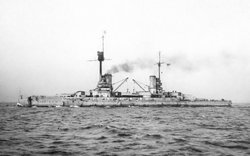 German Flag Ship Friedrich The Great at Jutland |
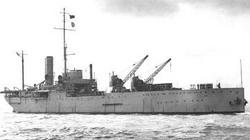 HMS Ark Royal -Sea Plane Carrier |
Counter Measures for U-Boat Menace
Destroyers and Lighter Ships
The British concluded that speedy ships was required to outrace a fleeing U-boat and deck weapons with the power to blow a surfaced submarine out of the water or ram it with its heavy bow. The Destroyer was the major counter weight. In 1917, the British fleet numbered 320 destroyers. The British government secretly approached the United States to build an additional destroyers for the Royal Navy.
Although there was building sentiment for the British, the Americans refused. The Anglo-Japanese Treaty provided military mutual assistance in the event either was at war. The American policy makers, presciently, viewed this as a possible threat to the United States in the event of an American war with Japan.
The destroyer became the weapon of choice, and the solution to protect merchant shipping from the U-boats. The convoys developed a zig zag pattern making it more difficult for the subs periscope to sight the target. The destroyer made a difficult target because of its shallow draft.
World War 1 Weapons World War 1 Weapons
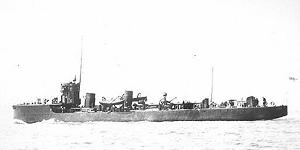 HMS Attack |
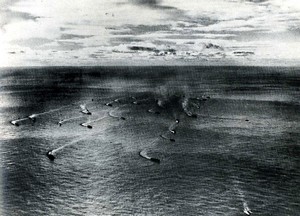 |
World War 1 Weapons
|
To complete the Atlantic convoy screen the British added armored cruisers. HMS Cochrane |
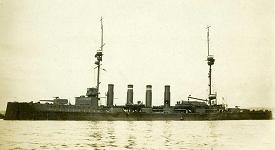 |
The smaller version of the destroyer was the torpedo boat. The vessel was built for speed and could operate at over 50 MPH. The German version of this boat was intended to engage in torpedo attacks against larger enemy vessels and carried from 2 to 4 torpedoes. They ranged in size from 50 to 100 feet and were lightly armored and carried small deck guns.
World War 1 Weapons World War 1 Weapons
 |
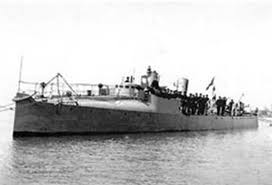 |
The British and Italians also introduced similar versions to the German torpedo boat. Two Italian torpedo boats in the stealth of night entered an Adriatic Sea harbor in December 1917. They targeted torpedoes at the anchored Austrian Majestic Class battleship, SMS Wien . These small boats with 16 man crews sunk a battleship with two well placed torpedoes.
World War 1 Weapons World War 1 Weapons
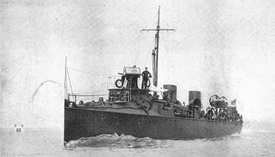 British HMS Hunt Wien |
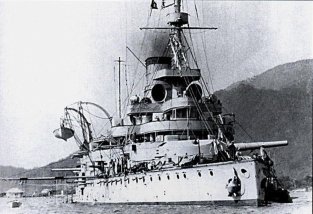 |
The torpedo boat served a useful purpose against surface ships, but a larger craft was necessary to protect merchantmen. The qualities of the torpedo boat were incorporated in the destroyer: speed, maneuverability and added size of explosive payload.The American Wickes -class destroyer was 314 long. It carried four 102 mm guns, heavily armored and had two depth charge racks. It operated at 35 knots. Their presence in the Atlantic convoys reduced the submarine toll by about 70%. Not any American troop ship was sunk.Between 1917 and 1919, the United States built 111 Wickes class destroyers.
On April 7, 1917, the United States entered the war. Its ships formed under the command of the Royal Navy. Within a month of the declaration of war, the mission of its destroyers was convoy duty in the Irish Sea. This sea had been open season for U-boat attacks on merchant ships. U.S. destroyers were ordered to destroy U-boats and the recovery and rescue of torpedoed crews. The Americans began the duty with 92 ships including 47 destroyers and 7 submarines. The destroyer proved to be the major enemy of the submarines although they were not impregnable.
In December of 1917, the USS Jacob Jones-61 was sailing off the southwest coast of England. The destroyer was a 100 ton boat, Tucker-class with eight torpedo tubes. It was sunk by U-boat 53. It sank immediately with the loss of 66 men.
World War 1 Weapons
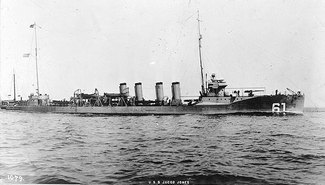
Destroyers carried a potent anti sub weapon---the depth charge. In 1914, high explosives were packed in a barrel shaped can that weighed about 300 pounds. (Later developments doubled that weight.) and fired from a K gun off the side of the ship. The canister would sink to a 300 foot depth--about the limits of a submerged sub in that era--and timed to explode on contact or at that depth. If the explosion was in a 20 odd foot radius of the target, it could rupture the submarine hull. The first confirmed depth charge success was in 1916 when HMS Llewellyn sunk U-boat 19.
World War 1 Weapons World War 1 Weapons
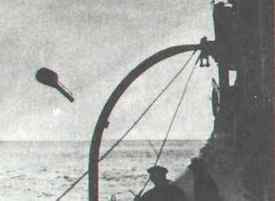 |
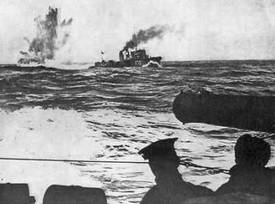 |
Technology provided an additional method for locating a submerged submarine. The destroyers were fitted with hydrophones (early sonar) on their bow and stern which could pick up sound waves from the submarines motors. Three boats acting in concert, could by triangulation pin point the exact location of the U-boat. The depth charges would follow.
World War 1 Weapons World War 1 Weapons
|
|
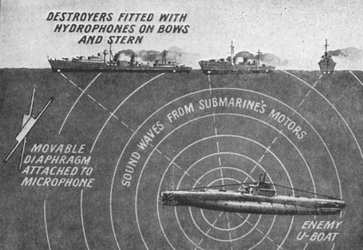 |
______________________________________________________________________
References and Sources:
American Military History, John W, Chambers. Ed., Oxford University Press.New York 1999.
Complete Encyclopedia of Arms & Weapons, Leonid Tarassuk and Charles Blair.SimonSchuster,NewYork 1999. Department of Air Force
Heyman, Neil M. World War 1,Greenwood Press, Westport, Ct 1997.
Imperial War Museum
Library of Congress
Manchester, William. The Arms of Krupp. Little, Brown and Company, Boston 1964.
National Archives
Reilly, Ralph. Reiley's @ world net.att. net
The Dictionary of the First World War, Stephen Pope and Elizabeth-Anne Wheal, St. Martin's Press, New York 1995.
The Encyclopedia of World War I, Spencer I. Tucker Ed. ABC-CLIO 2005
U.S. Air Service
Wikipedia
World Almanac, David R. Woodward, Facts on File New York 2009.
YouTube
To review Guns and Tanks see Contents above.Top of World War 1 Weapons
History of American Wars | Causes of World War 1 | World War 1 Weapons